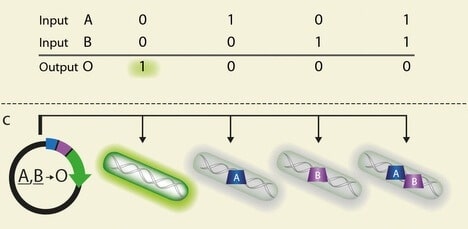In the distant future - so scientists hope - tiny computers will roam inside our bodies, equipped with medical knowledge, detect diseases in their initial stages and treat them on the spot by releasing appropriate medicine - without external intervention

In the distant future - so scientists hope - tiny computers will roam inside our bodies, equipped with medical knowledge, detect diseases in their initial stages and treat them on the spot by releasing an appropriate medicine - without external intervention. For this vision to take hold, computers need to be small enough to fit inside the body's cells. In addition, they must know how to "talk" with the various systems in the cell. The most effective way to deal with these two challenges is to create computers based on biological molecules, such as DNA or proteins. This is not a far-fetched idea, since biological creatures have evolved to be able to receive information, process it and respond to it - in a way reminiscent of the operation of a computer. Scientists from the Weizmann Institute of Science recently took an important step in this direction, when they managed to develop an independent genetic device that works successfully inside bacterial cells. The device is programmed to diagnose certain parameters, and react accordingly.
The device created by the scientists - Prof. Ehud Shapira and Dr. Tom Ran from the Department of Biological Chemistry and from the Department of Applied Mathematics and Computer Science - examines the presence of the transcription factors, proteins that regulate gene expression in the cell. In many cases, following the abnormal activity of these factors, the expression of various genes goes wrong, which leads to the development of a disease. Thus, for example, in cancer cells, the factors that regulate growth and division go wrong, which leads to increased cell division and the formation of a tumor. The device - which is made of a DNA sequence inserted into a bacterium on a plasmid - performs a sort of "presence test" of the transcription factors. If the test results match the parameters programmed into it in advance, it reacts by creating a protein that emits green light - thus providing an external indication for the "positive" diagnosis. In further studies, the intention is to replace the protein that emits green light with a protein that will affect the future of the cell, such as, for example, a protein that will cause the cell to commit suicide. In this way, the device will direct to their death only cells that have been diagnosed in a "positive" manner.
The first device created by the scientists is actually a NOR logic gate: this device is programmed to check the presence of two transcription factors, and respond by generating green light only if both factors are not present in the cell. Indeed, when the scientists injected the device into four types of genetically engineered bacteria: a type that produces both transcription factors, a type that produces neither, and two types that each produce only one of the factors, only the correct bacterial cells glowed green. Based on the first genetic device, the scientists later created more complex genetic devices, which implement logic gates known from the world of electronics engineering: an AND type logic gate (a genetic device programmed to diagnose and produce green light only if both transcription factors are present in the cell), an OR type logic gate (device a genetic device programmed to detect and produce green light only if at least one of the transcription factors is present), and a NOT type logic gate (a genetic device that detects the presence of one transcription factor, and produces green light only if it is not present in the bacterial cell). The results of the study, in which research students Yoni Doak and Lilac Milo also participated, were recently published in the scientific journal Scientific Reports.
Following the successful results with bacterial cells, the researchers plan to continue to examine how the bacteria can be programmed and "recruited" as an efficient and easy-to-operate system for medical purposes, which can also be easily injected into the human body (naturally, the human body has ten times more bacterial cells than human cells). Another goal is to activate a similar system inside human cells - which are much more complex than bacterial cells.
The scientific article:

6 תגובות
At today's rate of progress, I wouldn't be surprised if in a few years we really walk around with small computers inside the body and don't need the help of doctors
Already exists. We are the pinnacle of technology
It's amazing and sounds very tempting but on the other hand...
Who knows how the business will develop when we start putting chips in our bodies?
Yesterday it was the "biometric database" today it is medical chips and tomorrow matrix...